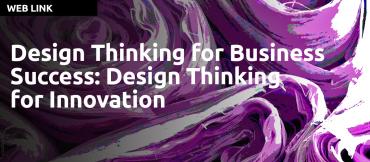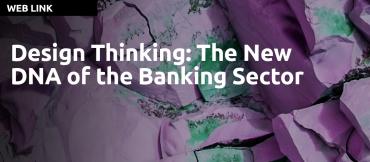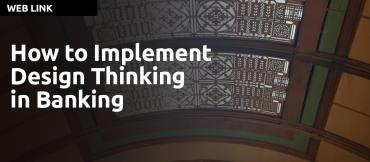
Is Design Thinking the new DNA of the Banking Sector? Design Thinking has been successfully used to create new value and solve complex problems in Banking by corporations such as Bank of America, BBVA, Citibank and Capital One.
Design thinking has become increasingly popular in the banking industry as banks look to improve their customer experience and stay competitive in a rapidly changing market. Design thinking is a human-centered approach to problem-solving that emphasizes empathy, collaboration, and experimentation. It involves understanding customer needs, generating ideas, prototyping solutions, and testing them in the real world.
There have been both successes and failures in the application of design thinking in banking. Some banks have successfully used design thinking to develop innovative products and services that meet the changing needs of their customers. For example, BBVA Bank in Spain used design thinking to develop its mobile banking app, which has been highly successful in attracting and retaining customers. The app is user-friendly, intuitive, and personalized, providing customers with a seamless banking experience.
Other banks have struggled to implement design thinking successfully. Some have failed to fully embrace the customer-centric approach of design thinking and have instead focused on internal processes and systems. As a result, they have developed products and services that do not meet the needs of their customers. Other banks have found it challenging to overcome organizational barriers and cultural resistance to change, which has hindered the implementation of design thinking initiatives.
Design thinking has the potential to transform the banking industry by improving the customer experience and developing innovative solutions to complex problems. While some banks have successfully implemented design thinking, others have struggled to achieve success. However, the increasing adoption of design thinking in banking suggests that it is a valuable approach that will continue to drive innovation and customer satisfaction in the industry.
Read case studies about the use of Design Thinking in Banking by these and other corporations. Read about their involvement with design thinking and the kinds of problems that have been tackled through the case studies and other articles about the use of design thinking in banking:
Design Thinking helps businesses to create user-centric products and services by discovering insights into user needs, applying these insights to their business model and generating innovative ideas.
In this five-part series, Sarah Dickins gives advice on how Design Thinking techniques can help you to orientate your product development around user need.
In 2017, employees, managers, and partners of Société Générale Global Solution Centre agreed that invoices based on time tracking and project allocation were a chronic and painful challenge.
At SG-GSC, customers were billed for the time each assigned employee worked. The process of collecting the time worked by those employees (HCC) was a complicated and difficult ordeal. It consumed 21 days per month for senior employees. These employees had to navigate different systems, many types of contracts, high staff mobility, and a variety of processes between business lines.
This is an example of accelerating a transformation through co-design. Eighty-two professionals gathered, representing OTP’s whole organization. Together, they were able to achieve months of work in just three days.
OTP Bank Romania (OTP) was at a key turning point in late 2018. The organization was undergoing changes in its leadership team. This new team helped them develop an ambitious goal:
OTP Bank will double its market share in 5 years.
The banking industry has become increasingly concerned over the challenge that emerging fintech startups pose to banks’ traditional ways of doing business and the threat that they present to revenue streams. In response, many banks have created internal innovation labs to counter these risks. “Design thinking” has become an important tool in the effort and is being used to explore how banks can boost their growth by applying the approach in a rapidly changing environment and an era of de-banking.
The hottest Trend in Banking is the use of Design Thinking to transform banking services.
If the one product you’re known for is ubiquitous, how can you stop your customers from leaving for other banks?
For Capital One, the answer was a small laboratory within the larger bank. The group leading this innovative push calls themselves Capital One Labs, and their secret weapon is free coffee.
According to the UXDA (UX Digital Advantage), the finance industry has experienced a turbulent period of Fintech disruption in recent years. In fact, 75% of the finance sector companies surveyed by KPMG stated that changing customer needs is the key area where disruptive Fintech companies have been challenging the traditional finance businesses. Although customers' needs are the basis for any business, in today’s competitive and customer-centric landscape, businesses must understand the customer on a much deeper level to come up with more innovative solutions.
Ever since it became clear that smart design led to the success of many products, companies have been employing it in other areas, from customer experiences, to strategy, to business ecosystems. But as design is used in increasingly complex contexts, a new hurdle has emerged: gaining acceptance (for the new solutions).
Co-creation and empathy are fundamental principles of design thinking that enable teams to collaborate and solve user problems at pace. Cross-functional collaboration and deep understanding of end-users help to break down barriers between organization silos, resulting in an aligned vision and more holistic, user-centered solutions. However, the geographically-dispersed nature of investment banks can make co-creation and empathy-building challenging.
Whether it is fintech, new regulations, or increasing customer demands, banks need to rethink the way they address wicked challenges related to designing and launching value-adding products and services that meet current and future customer needs. Design thinking has emerged as a highly effective and customer-centric method for solving these types of business problems.
It is based on observing customers in their natural environment, prototyping ideas, and validating them with real customers in an iterative way, working towards the best possible solution.
Service design includes all the intangible aspects of how an organization seeks to build a relationship over time with its customers. And one goal of prototyping these service design experiences is to bring tangibility to these intangible experiences. Prototyping is such a powerful tool because you're organizing your service around the needs of the end consumer. Prototyping is important for determining what lands correctly and what’s missing. It’s a way to depict how the experience might play out over time and to gather feedback around that.
Digitization of Services, especially in the banking sector is creating enormous risk for traditional banks who have not placed the customer at the center of their customer service activities. In general customers of physical banks are not very happy with their banks, whereas those at digital banks are much happier. Herein lies the risk for traditional physical banks. This report offers some good analytical information.
How banks can boost their growth through design thinking in a de-banking era.
There is broad concern in the banking industry that an important share of revenues and the traditional ways of doing business are at risk due to the emergence of fintech startups that are challenging the established players. In the current economic environment, banks are looking to adapt and evolve their business models to meet these challenges and opportunities. Design Thinking is proving to be a useful tool that can help banks in their endeavors.
How do you encourage new customers to open bank accounts? In 2004, Bank of America used the Design Thinking methodology to look at the problem from a human centered perspective when they assigned design agency IDEO to boost their enrollment numbers: a problem that at the time, lacked any user perspective on why it was so hard for customers to save.
How design thinking’s user-centric approach is helping Hong Kong embrace a cashless future.
The world is rapidly moving towards a cash-lite society with the continuing global spread of the coronavirus disease, Covid-19, helping to accelerate the demand for digital payment services.
Many people have been not only adopting social distancing measures during the pandemic, but also trying to avoid contact with people through the use of bank notes and coins by choosing digital payment methods or shopping online. Except in Hong Kong...
The examples of Design Thinking below demonstrate that it is a mindset and a methodology for problem solving that typically has 5-6 (cyclical) process steps that are easy to follow and can be implemented by anyone trying to solve a problem. Anyone, or any group of people can produce many good ideas using the Design Thinking process. The steps are designed to encourage the formation of new ideas focused around the users needs. As with any process, i.e. running, participants must develop and practice the skills required to produce excellence while using the process.















